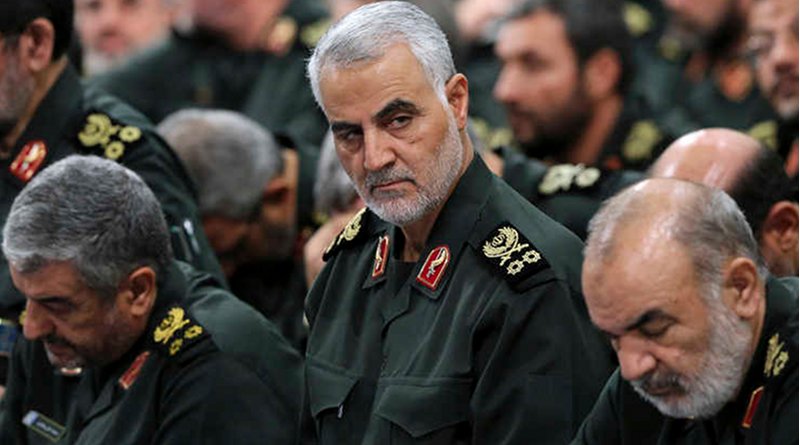The Killing Of Gen. Soleimani And The Islamic Republic’s Options – Analysis
By IPCS
By Majid Izadpanahi*
After a rocket attack on a US military base which led to the killing of an American contractor, the US blamed the Kata’ib Hezbollah (an Iran-backed proxy militia) and later plotted the bombing of a base belongs to that militia. Few days later, the seizure of a part of the US embassy in Baghdad, which was orchestrated by the same militia and their followers, led to US President Donald Trump blaming Iran for that incident, wherein he stated that they would pay a very big price. On 3 January, Gen Qasem Soleimani, the head of Quds Force—an overseas division of Iran’s Islamic Revolutionary Guard Corps (IRGC) that is responsible for the Islamic Republic’s ideological goal of export of revolution—was killed in a US drone attack after he left the Baghdad Airport along with Abu Mahdi Al-Muhandis, the deputy chief of the Popular Mobilization Committee and a Kata’ib Hezbollah member.
This attack was an enormous damage to the Islamic Republic’s prestige not only among its proxy forces but also among its followers domestically. This incident was the result of Tehran’s miscalculation for two reasons: firstly, after the sabotage of the tankers in the Persian Gulf, shooting down of a US drone, and attacks on Saudi Arabia’s oil facilities, Iran concluded that the US will continue its strategic tolerance and would not respond to any of the assaults. Secondly, given President Trump’s objective of winning the next US presidential election, policymakers in Tehran thought that he would avoid any war or reaction as it could harm his re-election prospects.
Soleimani’s Role in Iran’s Regional Policies
Founded in 1980, the Quds Force has, under Gen Solaimani’s command, has played a crucial role in Iran’s regional policy since the Arab Spring in Syria. Following the escalation in tensions between Tehran and Riyadh, Iran’s Ayatollah Khamenei supported the IRGC’s approach towards the developments in the Middle East and harsh policy vis-à-vis Saudi Arabia, and referred to Soleimani as a “Living Martyr.” The Ayatollah publicly expressed his discontent with negotiations with the US over the nuclear program under Iran’s President Hasan Rouhani-led administration.
After the Joint Comprehensive Plan of Action (JCPOA)—commonly known as the Iran nuclear deal—was signed, Ayatollah Khamenei prevented President Rouhani from pursuing another comprehensive agreement with regional powers over the future of the Middle East. Instead, the Ayatollah pursued two parallel polices, which were executed by the IRGC: missile program, and increasing regional influence. Gen Soleimani was a major player in the latter. He wielded extensive freedom to define policy lines regarding the issues in the Middle East, to the extent that it was he, not Foreign Minister Javad Zarif, who would define and conduct Iran’s foreign policy towards Middle Eastern states. For example, on one occasion, he brought Syrian President Bashar al-Assad to Iran while Zarif was kept uninformed. On some occasions, Zarif had to raise Gen Soleimani’s statements in order to consolidate his own position. Iran’s nominated ambassadors in Iraq and Syria too are former IRGC officers.
The Islamic Republic has always justified the IRGC’s presence in Syria—as part of the ‘Axis of Resistance’ crucial to the regime’s ideology—based on “preemptive war against [the Islamic State] ISIS” and “Strategic Depth,” because the public opposed such expensive presence. Gen Soleimani had strong links with the network of commanders of militias in the region. The Islamic Republic depicted Gen Soleimani as a national hero who protected Iran’s borders from ISIS attacks. According to the BBC’s Security Correspondent, Frank Gardner, both the Quds Force and Gen Soleimani reported directly to Ayatollah Khamenei, “bypassing Iran’s conventional military structures to become effectively an independent entity.” Jack Straw, who was the UK’s foreign secretary from 2001 to 2006 and who has visited Iran several times, believes that Gen Soleimani’s role goes well beyond that of a military commander.
Limits of the Islamic Republic’s Responses
Tehran options for responding to the killing of such a commander are limited. The US military is the most powerful one in the world, whereas the Iranian air force is old. Additionally, Iran is experiencing severe economic problems. In late 2019, country-wide protests took place against the mismanagement of the Islamic Republic, indicating a blow to the legitimacy of the regime. Media outlets reported that approximately 1500 had died during the protests.
Since the Islamic Republic’s propaganda machine depicted Gen Soleimani as a national hero who crushed ISIS and secured the country’s borders, Ayatollah Khamenei’s alternatives for responding to his killing involve indirectly targeting the US, such as:
- A diplomatic route involving requests to expel US forces stationed in the region (as seen in Iraq).
- Attacking US allies in the region, such as Saudi Arabia, and escalating proxy wars.
- Iran changing its participation in the JCPOA—a glimpse of which was seen in Tehran’s 5 January statement regarding its enforcement of the limits on centrifuge numbers under the Agreement.
- Carrying out attacks on US military bases while also making sure that there would be no casualties—such as by informing the US via the Iraqi government as was seen in the 8 January strike.
That being said, in pursuing his options, Ayatollah Khamenei also has to balance the expectations of his hard-line followers and regime survival as well as avoiding military confrontation with the US.
*Majid Izadpanahi is an intern at the Institute of International Relations Prague, and a former IPCS Research Intern.

